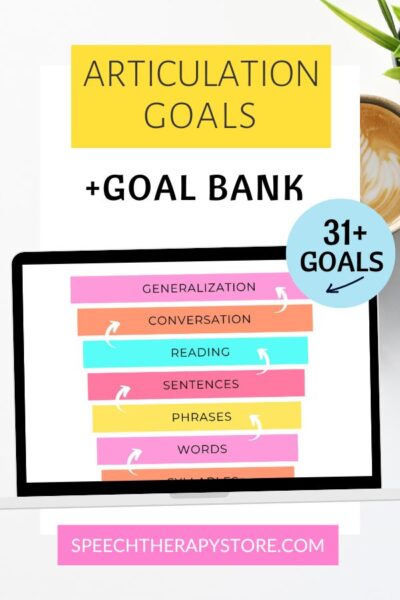As Speech-Language Pathologists we know that narrative goals are a crucial aspect of speech therapy, as they help individuals develop their language skills and improve their ability to communicate effectively.
Narrative goals can include a range of skills, such as:
- Understanding story structure
- Identifying main ideas
- Identifying key details
- Retelling stories in a logical and sequential way
Narrative development skills are essential for academic and social success, as they form the foundation for other language skills such as semantics, syntax, and pragmatics. Children who struggle with narrative skills may have difficulty understanding and expressing themselves, which can impact their ability to communicate effectively with peers and adults. By focusing on narrative goals in speech therapy, we can help individuals develop their language skills and improve their ability to communicate in a variety of settings.
In this article, we will discuss the importance of narrative skills in speech therapy, strategies for developing narrative skills, and how to implement narrative goals in individualized education plans (IEPs).
Key Takeaways
- Narrative skills are essential for academic and social success, and form the foundation for other language skills.
- A Speech Language Pathologist can use a range of strategies, such as visual and verbal cues, story elements, and language tasks, to develop narrative skills.
- By incorporating narrative goals into individualized education plans (IEPs) and speech therapy activities, we can help individuals achieve their language goals and improve their ability to communicate effectively.
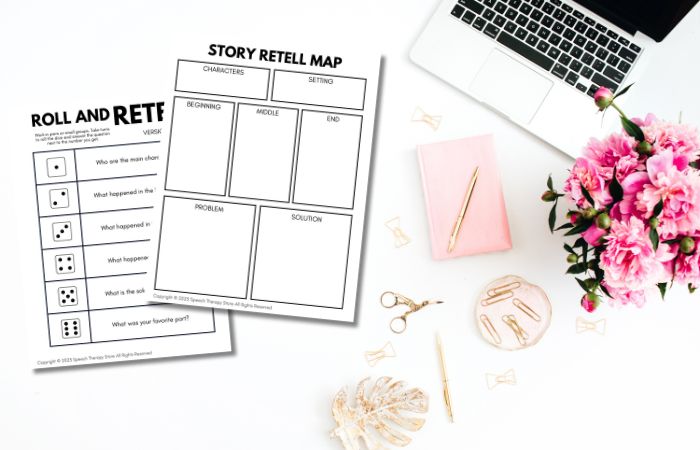
Understanding Narrative Goals in Speech Therapy
As speech therapists, we understand that narrative skills are essential for effective communication. Narrative skills include a client’s ability to understand and tell stories, which involves several language components such as vocabulary, syntax, and pragmatics.
These goals may include improving a client’s ability to:
- Understand story grammar (character, setting, problem, resolution)
- Sequence events in a short story
- Retell a story in their own words
- Use appropriate vocabulary and syntax when telling a story
To effectively address narrative goals, speech therapists should first assess a client’s current level of narrative skills. This assessment may involve analyzing a client’s ability to retell a story, identify story elements, and use appropriate vocabulary and syntax.
Once a client’s narrative skills have been assessed, speech therapists can develop specific narrative goals that are measurable and achievable. These sample goals should be tailored to a client’s individual needs and abilities.
The Importance of Narrative Skills
Developing narrative skills can improve language skills, including grammar, vocabulary, and comprehension. Additionally, narrative language can help promote better comprehension and the use of complex language.
The ability to tell a story is a key aspect of communication, and narrative skills can support social skills development. For example, telling stories can help children learn how to take turns in conversation, understand the perspectives of others, and engage in appropriate social interactions.
It is important to note that narrative skills develop over time and with practice. As speech therapists, we can support our clients in developing narrative skills by providing opportunities to work on storytelling skills, modeling appropriate story grammar elements, and providing feedback and support.
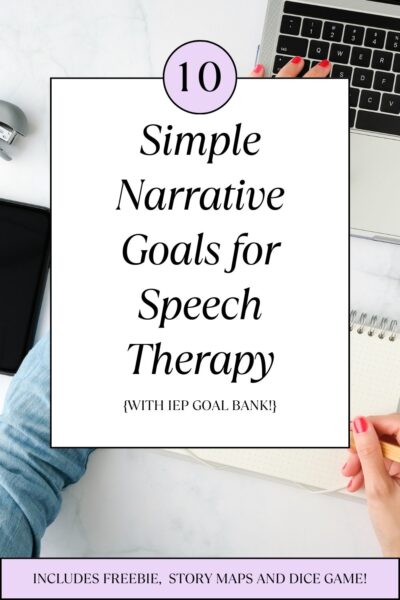
Narrative Goals for Speech Therapy
Sequencing
Given visual cues (e.g., sequencing cards) and a story, STUDENT will sequence the story including problem and solution with 80% accuracy in 4 out of 5 opportunities.
Given a story or activity, STUDENT will use sequence words to verbally order a story or activity (e.g., first, next, then, after, last) with 80% accuracy in 4 out of 5 opportunities.
Story Grammer
Given a story or activity, STUDENT will sequence the story or activity that includes story elements (e.g., character, setting, problem, goal, action, solution, ending) with 80% accuracy in 4 out of 5 opportunities.
Syntax
Given a story or activity, STUDENT will retell the story using 2-3 conjunctions (e.g., coordinating, subordinating, causal, and/or temporal) with 80% accuracy in 4 out of 5 opportunities.
Vocabulary
Given a story to retell, STUDENT will use descriptive language to retell the story with 80% accuracy in 4 out of 5 opportunities.
Given a story to retell, STUDENT will use 2-3 targeted tier 2 vocabulary to retell the story with 80% accuracy in 4 out of 5 opportunities.
Comprehension
Given a story or activity, STUDENT will identify the main idea and supporting details with 80% accuracy in 4 out of 5 opportunities.
Given a story or activity, STUDENT will answer yes or no questions with 80% accuracy in 4 out of 5 opportunities.
Given a story or activity, STUDENT will answer wh-questions with 80% accuracy in 4 out of 5 opportunities.
Personal Narrative
Given an opportunity to tell a story from their past, STUDENT will tell their story including 2-4 story elements and in a logical order with 80% accuracy in 4 out of 5 opportunities.
SEE ALSO: IEP Goal Bank Posts
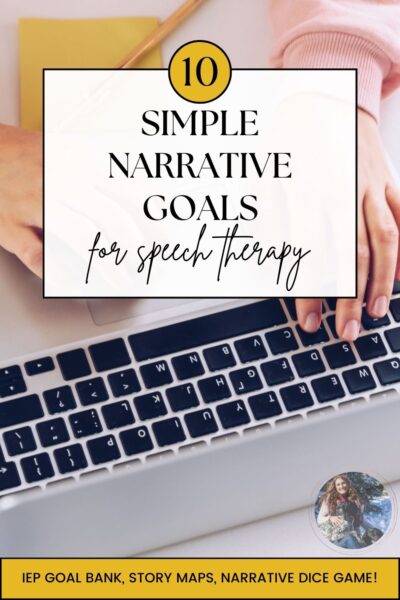
Strategies for Developing Narrative Skills
Developing narrative skills is an essential part of speech-language therapy. It helps to improve a child’s ability to understand and communicate stories in a logical and sequential way.
We use a variety of speech therapy activities and techniques to help our clients improve their narrative skills. These activities are designed to be engaging and fun, while also providing structured language activities that help build important language skills.
Here are 13 different strategies that we can use to develop narrative skills in children:
1. Verbal Prompts and Verbal Cues
Verbal prompts can be used to help children understand the structure of a story.
We can use prompts such as “Who was in the story?” or “What happened first?” to guide the child’s understanding of the story.
Verbal prompts or a verbal cue can also be used to encourage children to use appropriate vocabulary and sentence structures when retelling a story.
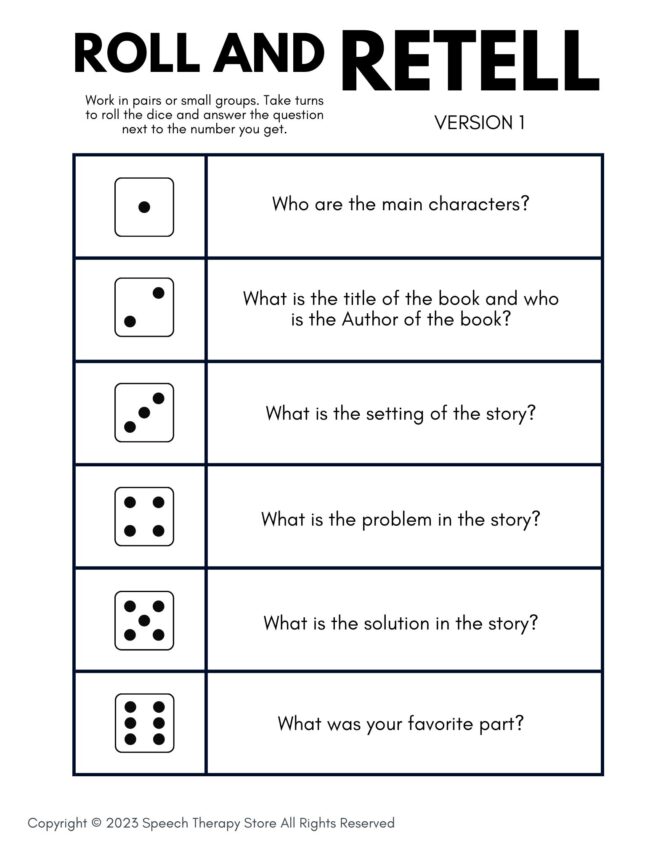
2. Visual Prompts and Visual Cues
Visual prompts such as a picture cue card or videos can be used to help children understand the sequence of events in a story.
We can use visual prompts to help children identify the characters, setting, and problem in a story.
Visual prompts can also be used to help children understand the emotions and motivations of the characters in the story.
3. Visual Support
Visual support such as storyboards or picture books can be used to help children understand the structure of a story.
We can use visual support to help children identify the characters, setting, problem, and solution in a story.
Visual support can also be used to help children understand the emotions and motivations of the characters in the story.

4. Graphic Organizers
Graphic organizers such as story maps or flowcharts can be used to help children organize the information in a story.
We can use graphic organizers to help children identify the main events in a story and how they are related.
Graphic organizers can also be used to help children understand the cause-and-effect relationships in a story.
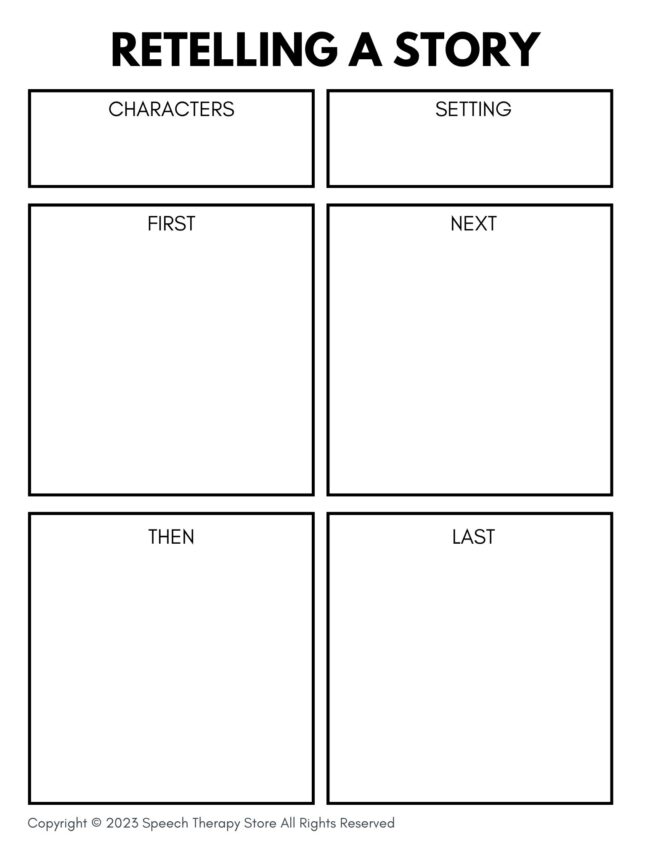
5. Identifying Story Elements
Story elements help us understand the main idea, main character, setting, problem, and solution of a story. By understanding these elements, we can better comprehend the main events and action sequences of a story.
A few ways to incorporate story elements is to use graphic organizers, picture books, or story maps.
- Graphic organizers – can help students organize their thoughts and understand the different story elements. For example, a graphic organizer can have sections for the main character, setting, problem, and solution.
- Picture books – are a great way to introduce story elements to students. As we read the book, we can point out the different story elements and ask questions to help students understand them. For example, we can ask, “Who is the main character?” or “What is the problem in the story?”
- Story maps – help students understand the sequence of events in a story and the cause and effect relationships between them. Story mapping involves breaking down a story into its key components, such as characters, setting, problem, and solution. This helps our clients understand the structure of a story and identify the main ideas and supporting details.

6. Story Comprehension
This involves asking the client to answer questions about a story they have heard or read, to ensure they have understood the key story elements and can recall important details.

7. Structured Activities
A structured activity such as games or worksheets can be used to help children practice their narrative skills.
We can use structured activities to help children identify story elements, retell stories, and create their own stories.
Structured activities can also be used to help children practice their vocabulary and sentence structure.
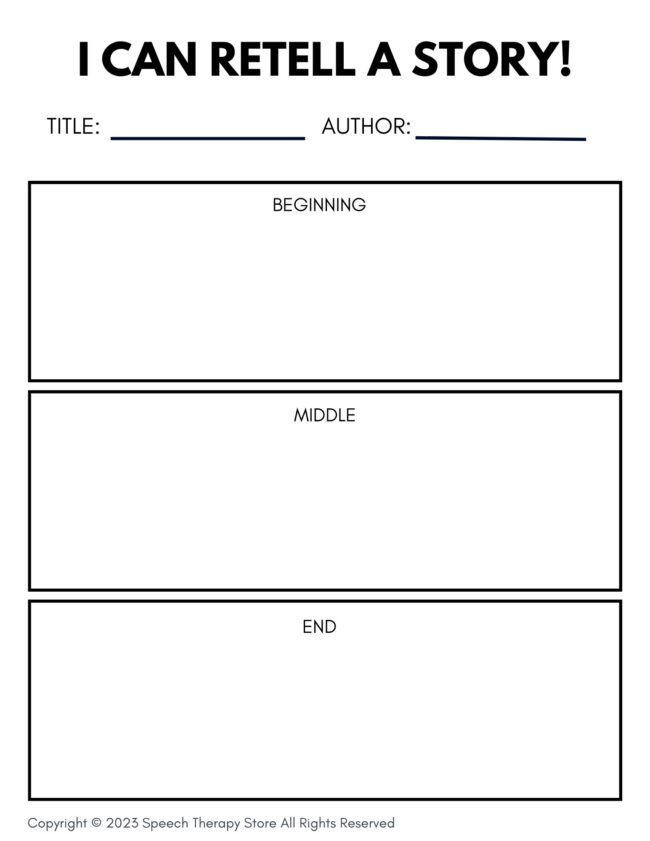
8. Play Session
Play sessions can be used to help children practice their narrative skills in a fun and interactive way.
We can use play sessions to help children act out stories, create their own stories, and practice their social skills.
Play sessions can also be used to help children practice their vocabulary and sentence structure.
9. Story Retell
Story retell is a technique that we can use to help children practice their narrative skills.
This involves asking the client to retell a story they have heard or read, focusing on the key story elements and relevant information. We may use visual aids or graphic organizers to help them organize their thoughts and remember the important details.
Story retell can also be used to help children practice their vocabulary and sentence structure.
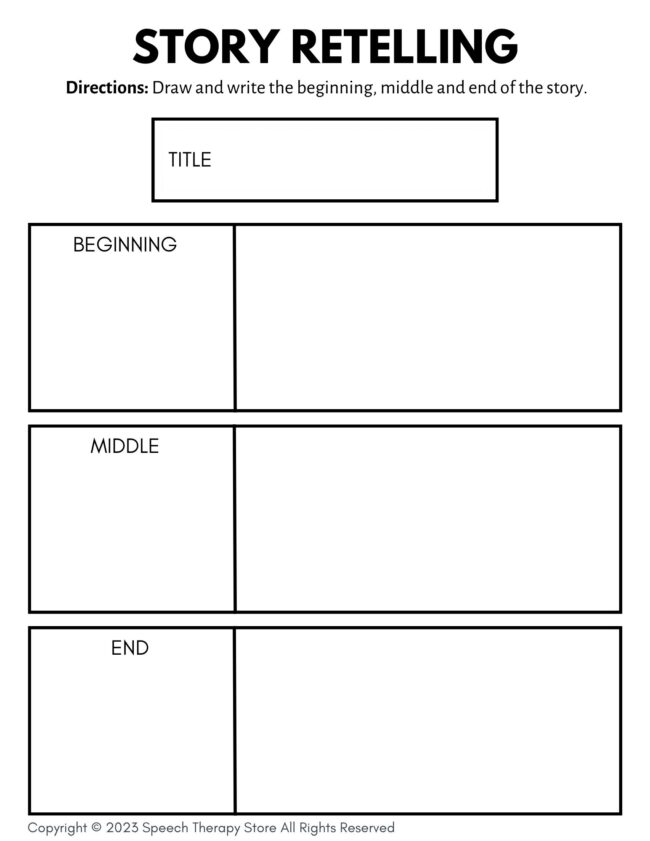
10. Role Playing
Another technique that we can use is role-playing. Role-playing allows our clients to practice their narrative skills in a safe and supportive environment.
For example, we might ask our clients to act out a scene from a story, using their own words to describe what is happening.
11. Fun Activities
We also use a variety of games and activities to keep therapy sessions engaging and fun.
For example, we might play a game of “Story Starters,” where we take turns adding to a story one sentence at a time.
This helps our clients practice their narrative skills in a playful and interactive way.
12. Story Generation Activities
This involves asking the client to create their own story, either in oral language or in written form (to also work on writing skills).
We may provide prompts or visual cues to help them get started and stay on track.
13. Personal Narratives
In speech therapy, personal narratives play a crucial role in helping students improve their language and communication skills. Personal narratives are stories that are based on a student’s personal experience, and they provide a great opportunity to work on story retell and story grammar marker skills.
One of the main benefits of using personal narratives in speech therapy is that they are highly engaging and relevant to the student. By using personal experiences, we can help students connect with the story and become more invested in the therapy process. This can lead to increased motivation and better outcomes.
In addition, we can also use personal narratives to help students develop their storytelling and conversation skills, which can be essential for success in both academic and social settings.
SEE ALSO: 179+ Wh Questions Free Printable
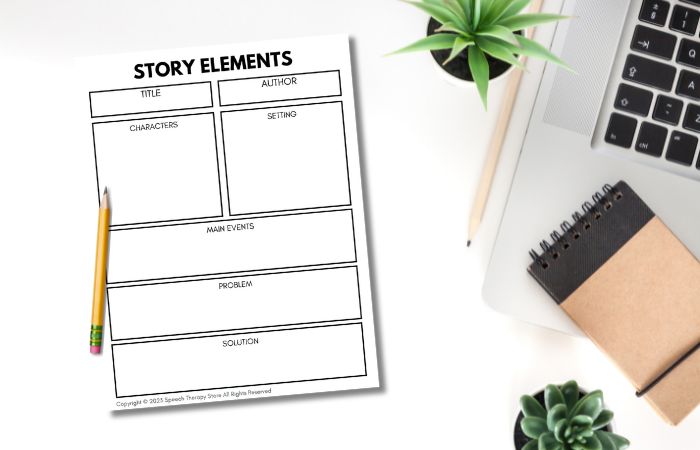
Measuring Progress Towards Narrative Goals
Data Collections
In order to know if your student is making progress it is essential that you as the therapist are measuring your student’s progress through data collection.
It is by consistently tracking your child or student’s progress that you can make informed decisions about therapy and more effectively communicate with other professionals or parents.
To ensure that you have the right measurable goals, focus on creating goals that are objectively measurable and specific to the individual’s needs. (see goals above)
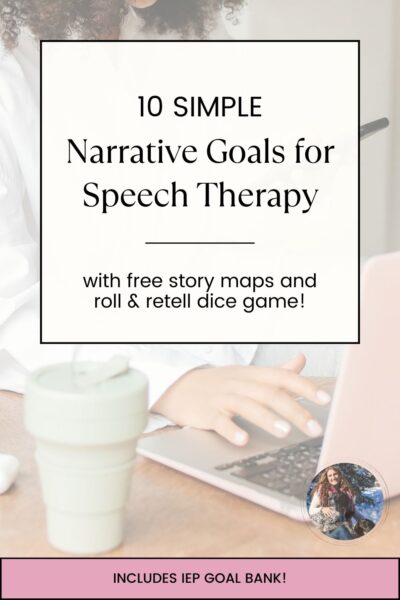
Need Other Speech Therapy IEP Goals?
Expressive and Receptive Language Goals
Expressive and receptive language goals focus on improving an individual’s ability to understand and use language effectively in oral communication.
Receptive Language Goals
Receptive language goals aim to improve an individual’s ability to understand spoken language. This includes the ability to comprehend vocabulary, follow directions, and understand basic concepts. Some examples of receptive language goals include:
- Identifying objects or pictures based on verbal descriptions
- Following simple and complex directions
- Answering “wh” questions (who, what, where, when, why)
- Identifying synonyms and antonyms
- Understanding figurative language, such as idioms and metaphors
Expressive Language Goals
Expressive language goals focus on improving an individual’s ability to use language effectively in oral communication. This includes the ability to use appropriate grammar and syntax, express thoughts and ideas clearly, and use appropriate vocabulary. Some examples of expressive language goals include:
- Using complete sentences with appropriate grammar and syntax
- Describing objects or pictures using appropriate vocabulary
- Telling stories with a clear beginning, middle, and end
- Using figurative language appropriately, such as idioms and metaphors
Articulation Goals
Articulation goals are to improve communication skills for individuals who face challenges in pronouncing words or sounds. These goals are what help guide your students’ speech therapy sessions to ensure the student or client actually makes progress toward their articulation skills.
When creating an articulation goal, speech therapists should consider various aspects, such as the phonemes involved, the position of the sounds within words (initial, medial, or final), and the student’s age-appropriateness to be working on those particular goals.
SEE ALSO: 21 Best Reinforcement Games for Speech Therapy
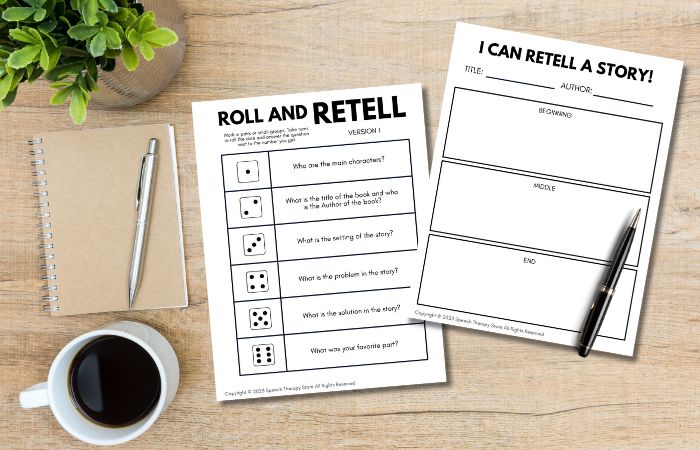
Narrative Therapy Ideas
I’ve gone ahead and gathered a few activities that you can use in your therapy room for working on your child or student’s narrative speech therapy goals.
Older Children
Here are a few narrative intervention lessons for older students in the school setting.
- Intro to Storytelling Personal Narrative Humans of NY FULL LESSON High School by Equitable ELA is a great introduction to narrative storytelling and photojournalism. High School students love this engaging lesson plan.
- Narrative Writing Lesson Plan | Youth Climate Stories | Free by SubjecttoClimate is a detailed lesson plan that prompts students to write narratives about climate change. This is great for middle school students!
- Narrative Writing (Inspired by a Picture) Lesson PowerPoint by Miss Hill Creates is a freebie that prompts students to write a narrative based on a picture. This freebie was created for 4th-8th graders.

Young Children
If you’re working with younger students and need a small group lesson plan here are a few resources you might find helpful.
- Narrative Writing Lesson and Anchor Chart by Rebecca McNamara is a set of great visuals about narrative writing and the components involved with it.
- K-5 Writing How to Catch an Elf Lesson Plan+ Video Resource+ Student Rubric by Ms. Ocasio is a 5 day lesson plan that is great for winter time. Students practice opinions, narratives and explanatory writing in this freebie.
- Free Writing Activity- Kindergarten Narrative Writing Lesson by Jessica Tobin – Elementary Nest is a great set of mini lessons to begin introducing narrative writing to younger students.
Simple Story
Here are a couple of simple stories that you could use to work on your student’s narrative skills.
- Free Story Element Story Telling Cards and Frames for Narrative Production by Susan Berkowitz is an engaging way to expand student’s narratives into simple stories.
- The Ant and the Grasshopper Text + Narrative Analysis Questions and Frames by Professor Todd is a simple story and accompanying worksheet that walks students through analyzing the story.
- Kayaking Chaos – Visual Prompt Short Story Worksheet with Modelled Sample by Luke Daly prompts students to write short stories with visual prompts. This is a great print and go activity.
Printable PDF
Here are a couple of simple stories that you could use to work on your student’s narrative skills.
- A Simple Hero’s Journey Organizer. Summarize. Story. Review. Plot. ELA. ESL by ELT Buzz Teaching Resources is a great organizing tool for this simple text that outlines a heroes journey to help students deconstruct narratives.
- Reading Comprehension Story – simple sequencing, inferencing, attributes by SLP Materials is a great simple story to get students thinking about attributes of a simple story.
- Free Simple Social Stories, How to be a good friend, Playing with my Sister by Elementary and Special Education Destination is an engaging set of simple stories for with symbol writing!
Classroom Teachers
If you need grade level short stories to practice narrative skills asking your child or students classroom teachers might be very helpful.
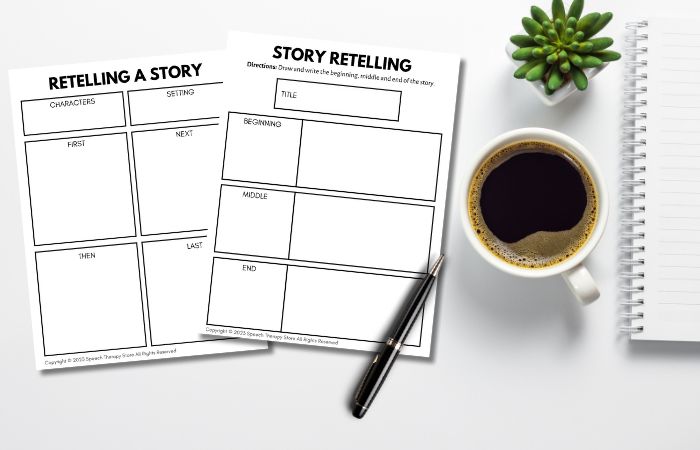
Conclusion
In conclusion, narrative language acquisition is a critical aspect of speech therapy for individuals of all ages. It is a fantastic way to promote better comprehension, use of complex language, and social skills. We have discussed some great ideas for narrative goals, including story retell, story generation, and character analysis. These goals can be tailored to meet the individual needs of each client and can be adjusted as progress is made.
One of the best ways to work on narrative goals is through the use of visual prompts, such as picture card cues and graphic organizers. These tools can help guide the client through the story elements and promote a deeper understanding of the narrative. Additionally, incorporating technology, such as digital storybooks or interactive apps, can make therapy sessions more engaging and exciting for clients.
It is important to remember that narrative goals should be measurable and specific, with clear benchmarks for progress. Regular assessments and data tracking can help ensure that therapy is effective and that the client is making progress toward their goals. By incorporating narrative speech therapy goals into our speech therapy sessions, we can help our clients develop critical language skills that will benefit them in all aspects of their lives.
Grab Your Free Story Retelling Maps and a Fun Roll & Retell Dice Game Here!
Simply enter your name and email to have this Narrative Goals Freebie emailed directly to your inbox!
Frequently Asked Questions
What are some effective activities for improving narrative skills in speech therapy?
There are many effective activities for improving narrative skills in speech therapy. Some examples include story retells, story generation, graphic organizers, and visual aids. When working on narrative skills, it is important to target all aspects of the narrative structure, including characters, setting, problem, and resolution.
What are some common goals for expressive vocabulary in speech therapy?
Common goals for expressive vocabulary in speech therapy include increasing the number of words a client can use, improving their ability to use descriptive language, and increasing their ability to use context clues to determine the meaning of unfamiliar words. It is important to target vocabulary that is relevant to the client’s daily life and interests.
What are some ways to work on describing skills in speech therapy?
There are many ways to work on describing skills in speech therapy. Some examples include using graphic organizers, describing pictures, and using sensory details. It is important to target a variety of descriptors, including size, shape, color, texture, and function.
What are some appropriate vocabulary goals for preschool-aged children in speech therapy?
Appropriate vocabulary goals for preschool-aged children in speech therapy include increasing the number of words they can use, improving their ability to use descriptive language, and increasing their ability to understand and use basic concepts. It is important to target vocabulary that is relevant to the child’s daily life and interests.
How can speech therapists teach and improve narrative skills in their clients?
Speech therapists can teach and improve narrative skills in their clients by using a variety of evidence-based interventions, including graphic organizers, visual aids, and story retells. It is important to target all aspects of the narrative structure, including characters, setting, problem, and resolution. It is also important to target vocabulary and descriptive language that is relevant to the client’s daily life and interests.
Want More Language Lesson Plans for Speech Therapy?
- 917+ Best Free Boom Cards for Speech Therapy
- 31 Best Wordless Videos to Teach Problem Solving
- 3 Most Common Irregular Plurals Flashcards
- 253+ Yes or No Questions for Speech Therapy
- 179+ Wh Questions Free Printable
Want the Best of the Bests?
Be sure to check out our most popular posts below!
- 21 Best Reinforcement Games for Speech Therapy / Teletherapy
- Best IEP Resources
- 71+ Free Social Problem-Solving Scenarios
- 430+ Free Multisyllabic Words List Activity Bundle
- 432+ Free Measurable IEP Goals and Objectives Bank
- 279+ Free Speech Therapy Digital Materials
- 179+ Free Speech Therapy Wh-Questions Printable


